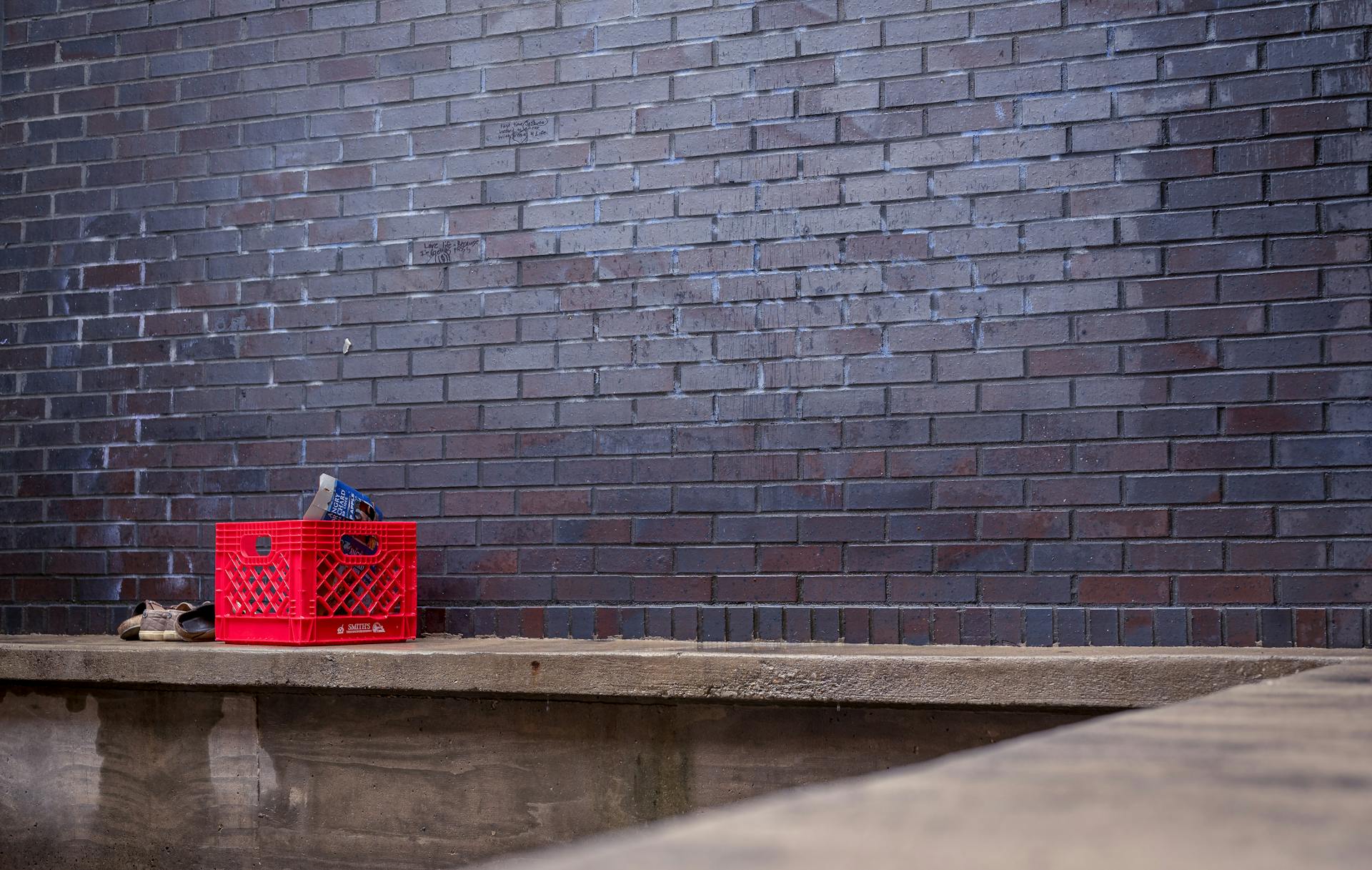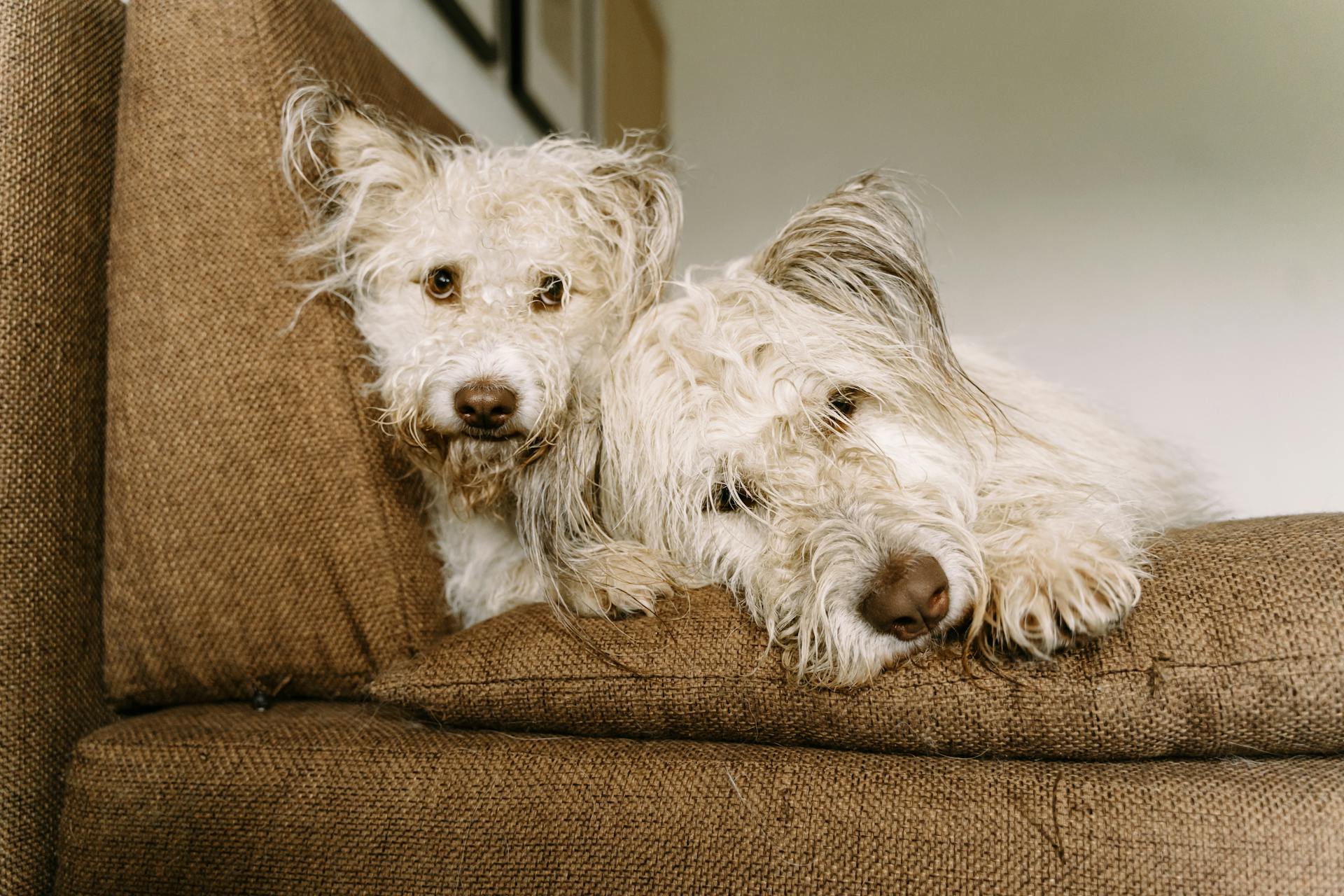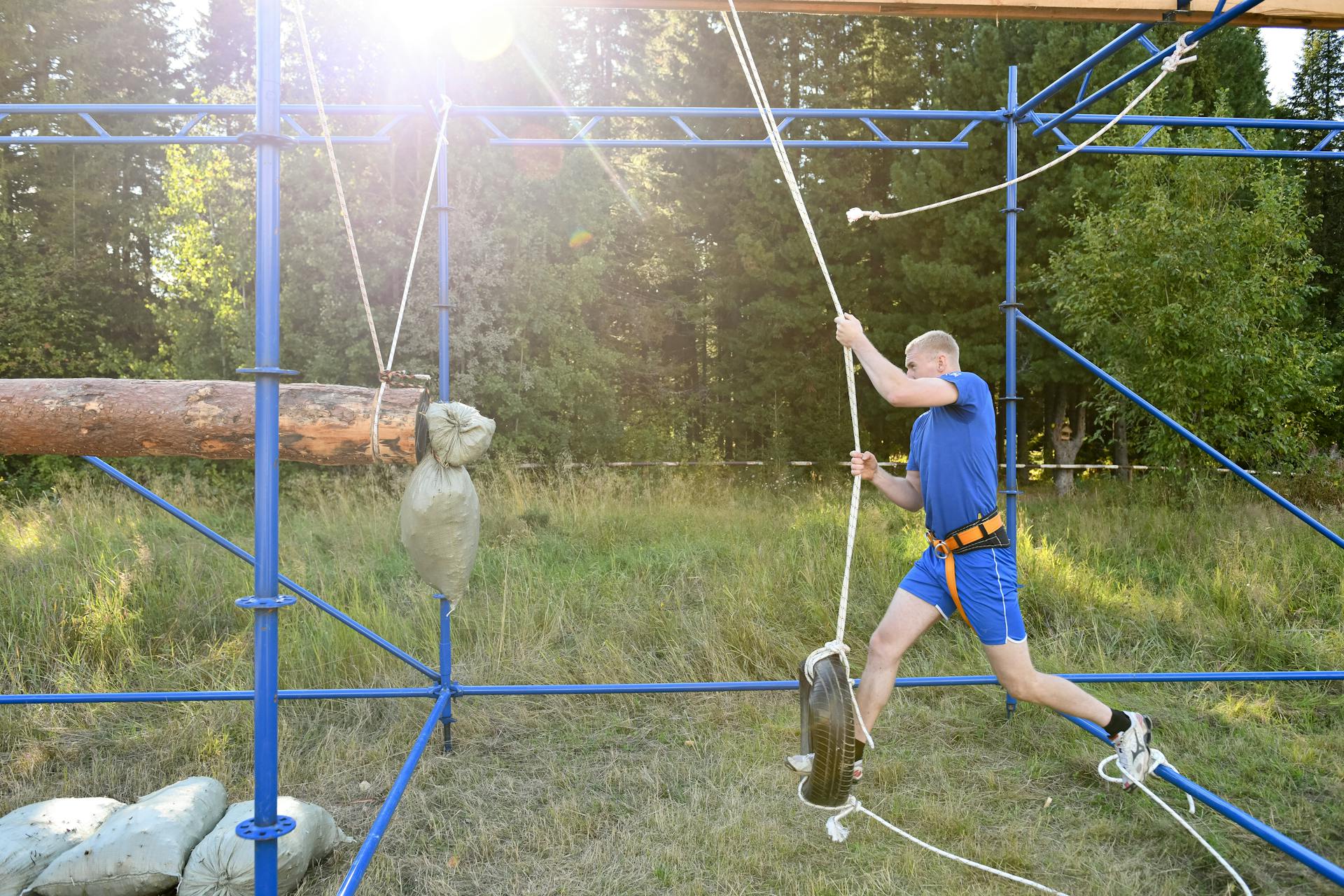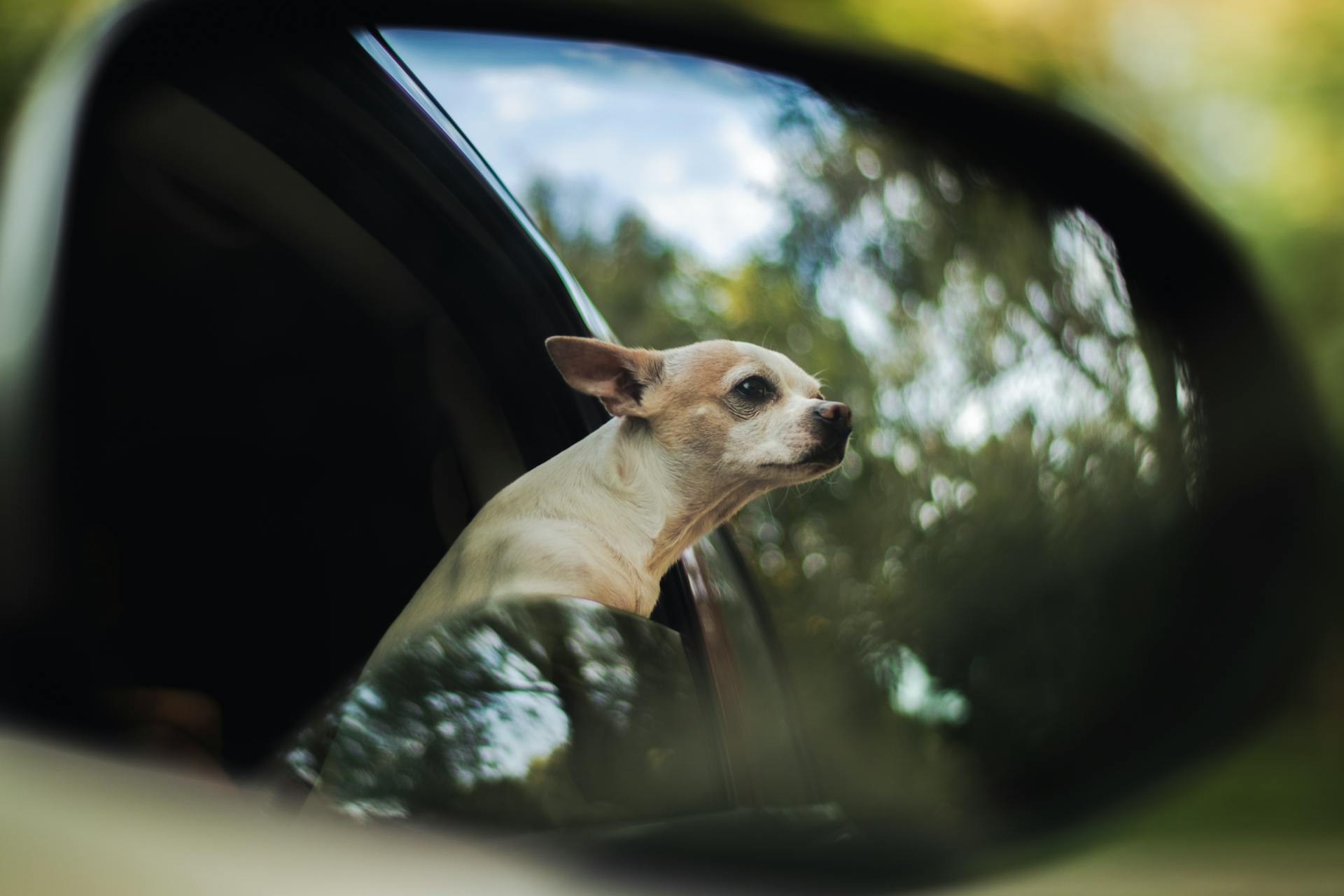
Crate training can be a game-changer for dogs with separation anxiety.
By creating a safe space for your dog to relax in, you can help reduce their anxiety and prevent destructive behavior.
According to studies, crate training can be up to 90% effective in reducing separation anxiety in dogs.
Dogs with separation anxiety often feel anxious when left alone, which can lead to destructive behavior like chewing or digging.
A Step-by-Step Guide to Crate Training
Crate training a dog with separation anxiety can take several months, so it's essential to remain patient and calm throughout the process. Positive reinforcement is the best approach, as punishment can increase anxiety and stress levels.
Start by setting up the crate in a quiet corner of the house where your pup will feel more at ease. Avoid busy areas like the kitchen or living room, as constant noise and movement can elevate stress levels. Every dog is different, and you know your dog best.
Expand your knowledge: Dog Training Levels
Leave the door open and encourage your dog to explore the crate. Praise them and reward them with a treat every time they look at the crate. If you use clicker training, click as soon as they engage with the crate. Shaping is a fantastic way to get an anxious dog to engage with training without feeling pressured.
To make the crate a positive environment, add a soft, cushioned bed inside the crate. A bolster bed with raised edges can help anxious dogs feel more secure. Add a blanket covered in your scent to provide comfort. Feed your pup their meals close to their crate, and gradually move their dinner bowl inside it.
Here are some tips to help your dog feel safe and comfortable in their crate:
- Add their favorite toys and treats to the crate
- Fill the crate with puzzle games to keep them entertained and happy
- Consider incorporating anxiety-relieving toys and calming sprays
- Swap out toys regularly to prevent boredom
Choosing the right crate is crucial, as it should ensure the safety and comfort of your dog. Consider the following factors:
- Wire crates offer excellent ventilation and visibility
- Plastic crates provide more enclosure and can be a haven for dogs seeking privacy
- Soft-sided crates are lightweight and portable, but may compromise on durability
- Size: Choose a crate where your dog can stand, turn around, and lie down comfortably
- Material: Consider durability, ease of cleaning, and comfort
- Location: Place the crate in a quiet yet accessible part of your home
Tips for Crate Training
Crate training can be a transformative experience for both dogs and their owners, especially for those with separation anxiety. It's not just about confinement, but about creating a sanctuary of safety and comfort.
To establish a profound trust between your dog and you, it's essential to never make the crate a punishment. This means avoiding using it as a "time out" if your dog misbehaves, as it can increase their anxiety and make them associate the crate with negative feelings.
Always ensure your dog is getting enough exercise and mental stimulation throughout the day, especially before you put them in their crate. This will help them feel more settled and at ease, as research has shown that a lack of daily exercise can increase separation anxiety in dogs.
Exercise and Mental Stimulation
Exercise and mental stimulation are crucial for a happy and healthy dog. Research has shown that a lack of daily exercise can increase separation anxiety in dogs.
Getting your dog enough physical activity throughout the day will help them feel more settled and at ease. Exercise should be a priority, especially before crate time.
Mental stimulation is just as important as physical exercise for your dog's well-being. Providing your dog with engaging activities will help keep them calm and relaxed when they're in their crate.
Check this out: Does Getting a Dog Neutered Help with Aggression
Never Make a Punishment
Using the crate as a punishment is a big no-no. It can actually make your dog's separation anxiety worse.
Dogs don't understand the difference between right and wrong like humans do, so they'll never associate the crate as a safe space if you use it to punish them.
The crate is meant to be a place of safety and comfort for your dog, not a time-out zone.
If you use the crate as a punishment, your dog's anxiety will rise through the roof whenever they're put in it.
For another approach, see: Why Does My Male Dog Lick My Female Dogs Pee
Addressing Separation Anxiety
Crate training is just one part of the solution to tackle separation anxiety in dogs. There are other measures you can try to help your dog be comfortable with being alone.
Desensitization and counter-conditioning are two effective methods to address separation anxiety. Desensitization involves exposing your dog to stimuli they find stressful in a non-confrontational way over a period of time. Counter-conditioning is about associating the absence with positive experiences.
To desensitize your dog to departure cues, you can follow these steps: put your dog in their crate and wait until they're settled, then act out one of your departure cues, wait a few minutes, and put any items away. Repeat this process, increasing the duration and trying it in different rooms of the house.
You can also vary when you leave your dog alone to prevent them from becoming anxious. Regularly change up when you leave your dog alone, doing daily tasks at different points of the day. This will help your dog learn to focus on other things rather than your departure.
Here are some common signs of separation anxiety in dogs, and what you can do about them:
- Whining or barking: consider consulting a pet behaviorist to differentiate between distress and attention-seeking.
- Reluctance to enter: try placing their food bowl inside the crate or sharing meal times near it to create a positive association.
Addressing the Root Cause
Crate training is just one part of the solution to address separation anxiety in dogs. It's essential to tackle the underlying cause of this issue.
Desensitization is a key method to help your dog become comfortable with being alone. This involves exposing your pet to stimuli they find stressful in a non-confrontational way over a period of time.
To desensitize your dog, start by putting them in their crate and waiting until they're settled. Then, act out one of your departure cues, such as picking up keys or putting on a coat, without leaving the room.
Gradual exposure is crucial in desensitization. You can start by simply fiddling with your keys or moving your coat, then gradually increase the duration and intensity of the cue.
Desensitization is most effective when done sporadically throughout the day. This helps your dog become accustomed to the departure cues without associating them with your actual departure.
Here are the main treatment methods you should consider:
- Desensitization
- Counter-conditioning
- Medication
- Anxiety-relieving supplements
Emotional and Behavioral Signs
Dogs exhibiting separation anxiety often show signs like excessive barking, destructive behavior, attempts to escape, pacing or restlessness, and extreme stress.
These manifestations can be triggered by various events or changes in their environment, such as a shift in their daily routine, moving to a new home, or extreme stress from the absence of a family member.
Excessive barking is a common sign of separation anxiety, but it's essential to differentiate between barking due to distress and barking to get attention.
Dogs may also exhibit destructive behavior, such as chewing or digging, when left alone.
A dog's natural den instinct can offer insights into their behavior, as they often seek enclosed spaces for safety and protection.
Here are some common signs of separation anxiety in dogs:
- Excessive barking
- Destructive behavior
- Attempts to escape
- Pacing or restlessness
- Dog exhibits extreme stress
Understanding these signs can help you identify whether your dog is experiencing separation anxiety and take steps to address the issue.
Training and Preparation
Crate training can be a transformative experience for dogs with separation anxiety, but it requires patience and understanding. A successfully crate trained dog is not just confined, but has a sanctuary of safety and comfort.
Building trust between the dog and owner is a crucial aspect of crate training. Successful crate training establishes a profound trust where the dog learns and recognizes the crate as a place of safety, not punishment.
The crate becomes a retreat for a dog with separation anxiety, a place where the chaos of the world fades away. For a dog, the outside world can be overwhelming, and the crate provides a sense of security.
Creating a safe space for your dog is essential, and crate training can help achieve this. A well-trained dog will learn to associate the crate with feelings of safety and comfort.
To help your dog feel safe and comfortable in their crate, there are a few things you can do. These include making the crate a welcoming space with a comfortable bed and familiar toys.
Here are some steps to help your dog become comfortable alone in their crate:
- Walk a few steps away from your dog after they enter the crate.
- Return to the crate and reward your dog with a treat after a few seconds.
- Repeat this process, slowly increasing the distance and duration.
- Initially, leave the room for only a few seconds at a time, and don't shut the door on them.
- Ignore your dog until they're calm and settled before rewarding them with praise and treats.
Common Challenges and Solutions
Crate misuse can have negative impacts on a dog's behavior and perception of the crate, potentially increasing the dog's stress.
Dogs shouldn't be confined for extended periods, and regular breaks and interactions are vital. It's essential to ensure your dog isn't spending more time in the crate than out of it.
Whining or barking could be a sign of distress or just a way to get your attention, so it's crucial to differentiate between the two. If it's the former, consider consulting a pet behaviorist.
Some dogs might be hesitant to enter the crate initially, but sharing meal times near the crate or placing their food bowl inside can create a positive association.
Puppies under six months of age shouldn't stay in a crate for more time than they can control their bladders and bowels, which is one hour for every month of age up to six months.
If your dog whines or cries while in the crate at night, try to ignore the whining, as yelling or pounding on the crate will only make things worse.
Recommended read: Crate Training Schedule by Age
Final Thoughts and Considerations
Crate training a dog with separation anxiety requires patience and persistence, but it can be a game-changer for their happiness and well-being.
It's worth noting that crate training can provide a safe space for your dog to feel at ease throughout the day.
Crating your dog can help alleviate separation anxiety, but it's not a one-size-fits-all solution.
Readers also liked: Healthy Mind Canine - Separation Anxiety Training
Frequently Asked Questions
How to calm an anxious dog in a crate?
Provide mental stimulation in the crate with puzzle toys or treats like peanut butter-filled Kongs to calm an anxious dog. This helps distract them from stress and keeps them occupied
Sources
- https://dogacademy.org/blog/crate-training-dog-separation-anxiety/
- https://furlyfe.com/mastering-crate-training-the-ultimate-guide-to-alleviating-dog-separation-anxiety/
- https://www.oregonhumane.org/portland-training/crate-training-your-dog/
- https://canineminded.com/calm-dog-separation-anxiety/
- https://www.thepuppyacademy.com/blog/2021/5/17/puppyhood-made-easy-for-new-owners-how-to-deal-with-separation-anxiety-in-puppies
Featured Images: pexels.com


